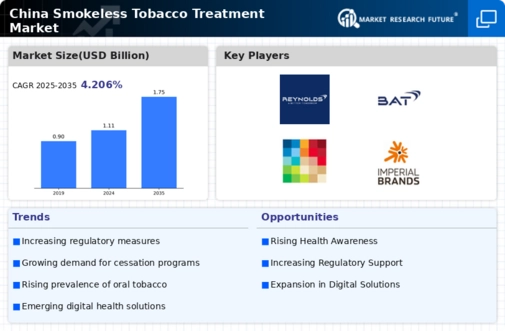Economic Incentives for Cessation
Economic incentives for cessation are becoming a notable driver in the smokeless tobacco-treatment market. With the rising costs associated with healthcare and the economic burden of tobacco-related illnesses, individuals are increasingly motivated to quit smokeless tobacco. Financial incentives, such as subsidies for cessation programs or insurance coverage for treatment options, can significantly impact user behavior. In China, where healthcare costs are a growing concern, the smokeless tobacco-treatment market may see increased participation as users seek to alleviate financial pressures. Furthermore, employers are recognizing the benefits of promoting a tobacco-free workforce, leading to the implementation of workplace wellness programs that include cessation support. This trend suggests that economic factors will continue to play a crucial role in shaping the smokeless tobacco-treatment market, as both individuals and organizations seek to reduce the financial impact of tobacco use.
Government Regulations and Policies
Government regulations and policies play a pivotal role in shaping the smokeless tobacco-treatment market. In recent years, the Chinese government has implemented stricter regulations on tobacco advertising and sales, particularly targeting smokeless tobacco products. These measures aim to reduce consumption and promote public health. As a result, there is an increasing need for cessation programs and treatment options to support users in quitting. The smokeless tobacco-treatment market is likely to benefit from government funding and initiatives aimed at reducing tobacco use. For instance, the National Health Commission has launched campaigns to educate the public about the dangers of smokeless tobacco, which may lead to a higher demand for treatment services. This regulatory environment creates a favorable landscape for market growth, as stakeholders align their offerings with government objectives to combat tobacco use.
Cultural Shifts and Changing Attitudes
Cultural shifts and changing attitudes towards tobacco use are emerging as significant drivers for the smokeless tobacco-treatment market. In recent years, there has been a noticeable shift in public perception regarding the acceptability of smokeless tobacco. Increasingly, societal norms are favoring healthier lifestyles, leading to a decline in the stigma associated with seeking help for tobacco cessation. This evolving mindset encourages individuals to pursue treatment options more openly. The smokeless tobacco-treatment market is likely to benefit from this cultural transformation, as more people recognize the importance of quitting and seek support. Additionally, educational campaigns aimed at dispelling myths about smokeless tobacco may further enhance awareness and drive demand for treatment services. As attitudes continue to evolve, the market may experience a surge in interest and participation in cessation programs.
Rising Prevalence of Smokeless Tobacco Use
The increasing prevalence of smokeless tobacco use in China is a critical driver for the smokeless tobacco-treatment market. Recent studies indicate that approximately 28% of adult males in China use smokeless tobacco products, which has raised public health concerns. This trend has prompted a growing demand for effective treatment options. As awareness of the health risks associated with smokeless tobacco rises, more individuals are seeking assistance to quit. the smokeless tobacco-treatment market is expected to expand as healthcare providers and organizations develop targeted interventions to address this issue. Furthermore, the economic burden of tobacco-related diseases, estimated at over $200 billion annually, underscores the urgency for effective treatment solutions. This situation creates a significant opportunity for market players to introduce innovative therapies and support systems to help users transition away from smokeless tobacco products.
Technological Advancements in Treatment Solutions
Technological advancements are significantly influencing the smokeless tobacco-treatment market. Innovations in digital health, such as mobile applications and telehealth services, are emerging as effective tools for supporting individuals in their cessation efforts. These technologies provide personalized treatment plans, real-time monitoring, and access to professional guidance, which can enhance the likelihood of successful quitting. In China, the integration of technology into treatment solutions appears to resonate well with younger demographics, who are more inclined to utilize digital platforms. The smokeless tobacco-treatment market is likely to see an increase in demand for these tech-driven solutions, as they offer convenience and accessibility. Moreover, the potential for data analytics to track user progress and outcomes may further refine treatment approaches, making them more effective and tailored to individual needs.















Leave a Comment